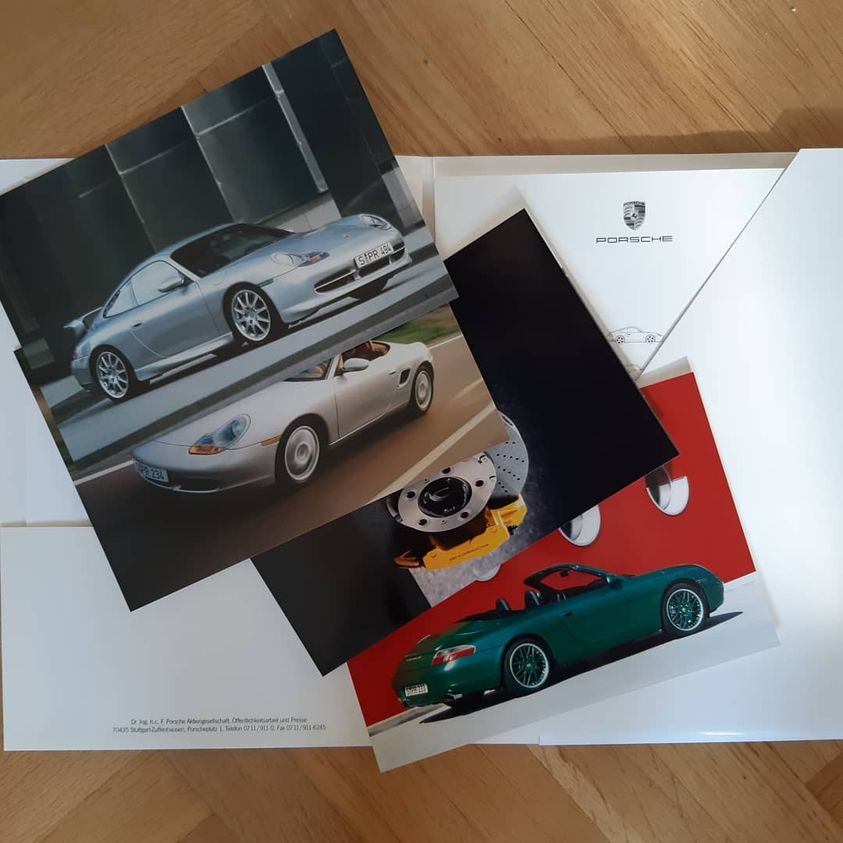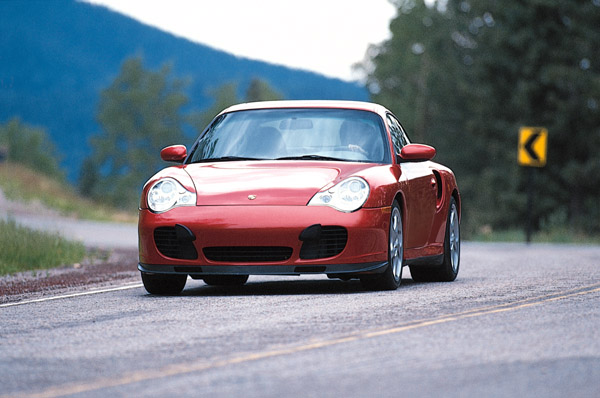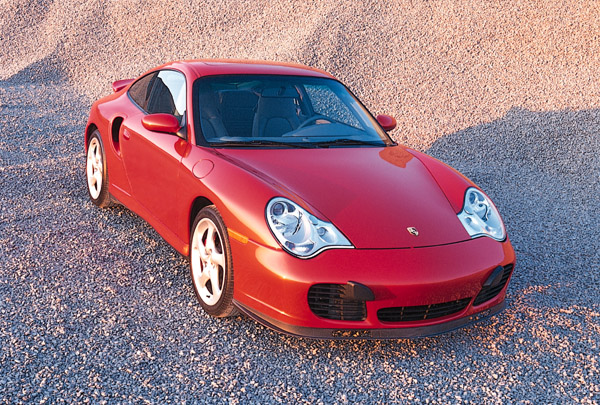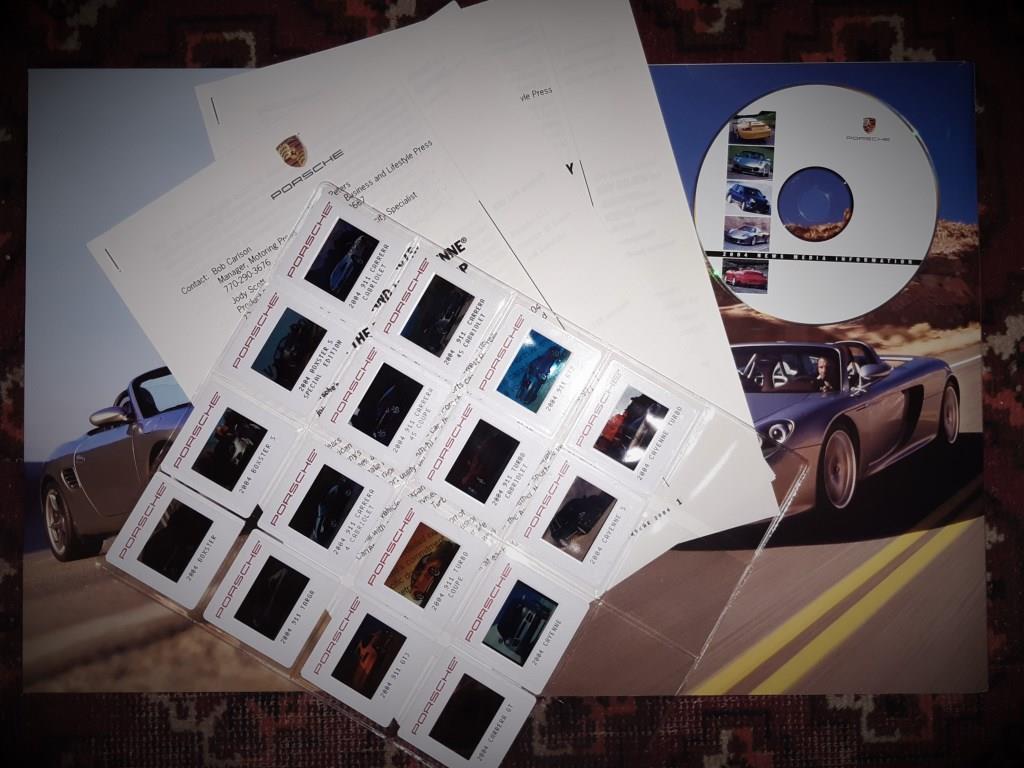
Porsche Press kit 2000

Like a house, a car is only as strong as the foundation on which it is built. Commonly called a “chassis,” the foundation really encompasses the car’s body s t r u c t u re, front and rear suspension and brake systems. Just as a solid foundation provides the basic integrity and strength in a house, a car’s foundation largely defines its handling responsiveness, passive safety capability, ride comfort, and long-term durability. “The stronger the better” applies equally to the foundations of houses and cars.
Porsche has achieved significant gains in body stiffness over the previous - generation 911™ Turbo, increasing torsional stiffness in the 2001 model by 49 percent and bending stiffness by 82 percent.
The 911 Turbo unit body incorporates welded box sections and bolt-on front fenders. Steel makes up the entire unit body structure, including high-strength low-alloy (HSLA) steel and boron steel for high-load and safety-critical areas. Aluminum accounts for about 20 percent of the car’s weight. However, Porsche uses aluminum mainly for the mechanical systems, including the engine, the transmission case, suspension components, brake calipers, and wheels. The automaker believes steel provides the best combination of strength, safety, weight, and repairability for the unit body and exterior body panels.
Porsche builds a small percentage of the 911 Turbo structure – the front bulkhead, rear inside sidemembers and rear floor section – using tailored blanks. Offering greater rigidity than large single pressings – especially for complex shapes – tailo red blanks start as separate sheet steel pieces made from diff e rent thickness and properties. Laser welding subjects the pieces to little heat, producing one larger distortion-free blank. Deep-drawing the blank produces a tailor-made panel of exceptional strength, yet low weight.
Designed for pure driving pleasure, the new 911 Turbo also offers extraordinary passenger protection. Advances in passive safety – the ability of the car and its systems to protect the occupants in a collision – include a Porsche-patented design for front and rear impact energy absorption and dissipation, an extremely rigid passenger compartment, and the Porsche Side Impact Protection System.
Because the term “crumple zone” has become commonplace in the auto industry, it’s important to describe the Porsche-patented system. In a frontal impact, several defined energy paths direct impact energy toward the high-strength steel bulkhead and sidemembers. Front and rear crumple zones protect the extre m e l y rigid passenger compartment.
Porsche arranged front impact protection in two tiers. The first tier includes the front lateral body shell members. The front longitudinal members and bulkhead crossmembers behind the luggage compartment form the second tier. The front-mounted fuel tank and fuel pipes lie outside the crumple zone. The rear crumple zone dissipates crash energy in a similar way, with the rear bulkhead designed to prevent engine intrusion into the passenger compartment.
Porsche has equipped all its cars with dual airbags as standard equipment since 1989.
In the 2001 911 Turbo – as in the 911 Carrera models – the Porsche Side Impact Protection System includes boron steel door reinforcement beams, energy-absorbing door panels, and door-mounted side airbags. The 30-liter capacity sidebags provide protection for the chest, head and pelvis. Airbags supplement the protection offered by the three-point seatbelts.
At a customer’s request, a Porsche dealer can install a system that deactivates the passenger airbags when a Porsche-approved child seat is used. The system features a cross brace with belt lock in front of the passenger seat. Buckling the special child seat into this brace deactivates the airbags. To install the system, the dealer also must reprogram the airbag control module.
The 2001 911 Turbo offers a combination of handling response and everyday ride comfort not usually associated with cars of its performance level. The 911 Turbo is equally adept at commuting as it is at shining at high-performance racetrack driving events. Compared to the previous 911 Turbo, the new model features a 3.2-inch longer wheelbase to accommodate new crash structures and to improve stability and ride comfort. Although the suspension layout is the same as in the 911 Carrera, the 911 Turbo adopts several parts from the 911 GT3 (a normally aspirated, limited-production model not imported to North America), including mounting points for the car’s main systems and the longer rear track control arms.
The Porsche-optimized MacPherson strut design uses aluminum lower control arms, aluminum wheel carriers, an aluminum crossmember, coil springs, twin-tube gas-charged shock absorbers and a 0.95-inch (24 mm) diameter stabilizer bar. The aluminum crossmember carries the lower control arms, diagonal steering arms, and the rack-and-pinion steering.
The MacPherson strut design provides exceptional lateral and longitudinal rigidity with low unsprung weight. Negative steering offset helps stabilize the car under varying braking forces, including ABS intervention. The suspension geometry reduces brake dive.
The new 911 Turbo models feature a refined version of the multilink suspension introduced on the previous-generation 911 Turbo. The suspension components mount to an aluminum subframe, which itself provides lateral reinforcement and noise isolation for the unit body.
Five aluminum control arms locate each wheel – three lower control arms (toe control arm, transverse arm and diagonal strut) and two upper control arms. Conically shaped, progressive rear springs mount non-concentrically around monotube shock absorbers (versus twin-tube shocks in the front). As in the front, spring and shock absorber tuning are tighter than in the 911 Carrera 4. A 0.87-inch (22 mm) stabilizer bar completes the setup. Suspension geometry reduces squat during acceleration.
Longer rear track control arms from the racecar-based 911 GT3 widen the rear track of the 911 Turbo by 1.57 in. (40 mm) over the 911 Carrera 4.
The rear suspension features the “Weissach axle” toe-control concept – so named for its development at Porsche’s Weissach, Germany Research and Development Center. During cornering, the toe control arms effect slight toe-out on the outside wheel and slight toe-in on the inside wheel. This self-steering response helps generate stable, neutral handling in the new 911 Turbo.

Derived from the Porsche GT1 racecar (and also used on the 911 GT3 and 911 Carrera models), the 911 Turbo four-wheel vented disc brakes use innovative one-piece (“monoblock”) brake calipers that contribute to quick brake release for reduced heat and optimal brake pedal travel and feel. The monoblock design reduces unsprung weight because it does not require the connection bolts of a two-piece caliper. The four pistons in each caliper vary in diameter to help prevent uneven brake wear, and, compared to the 911 Carrera 4, the 2001 911 Turbo uses larger, reinforced calipers.
The front and rear brake discs from the 911 GT3 measure 13.0 inches in diameter (330 mm), but differ in thickness – 1.34-inch (34 mm) in front and 1.1-inch (28 mm) in the rear. Overall, the larger brakes provide five percent more swept area compared to the previous 911 Turbo.
The cross-drilled discs dissipate heat to maintain braking performance and brake feel even under hard usage. By comparison, the 300-horsepower 911 Carrera 4 uses the same brake system, but with smaller discs -- 12.5-inch diameter x 1.1-inch thick (318 mm x 28 mm) in front and 11.8-inch diameter x 0.95-inch thick (299 mm x 24 mm) in the rear. Cooling air flows to the front discs through two ducts and through guide spoilers on the longitudinal suspension arms.
The 2001 911 Turbo introduces the first ceramic composite brake discs on a production car. The Porsche Ceramic Composite Brake (PCCB)®, available as an option, will set new standards for brake response, fade resistance, and service life. Porsche dealers can retrofit the discs to 2001 911 Turbos originally ordered without the option.
While about the same size as the standard cast iron brake discs, the PCCB weighs 11 pounds less per wheel – a 50 percent weight reduction. The lower weight reduces unsprung mass and improves suspension response. The PCCB provides optimal braking performance even under extreme conditions, on dry or wet roads.
An extremely hard disc surface together with immunity from salt corrosion will give the PCCB a long service life. Combined with new composite metal brake pads, the discs provide more consistent friction than iron discs during hard, repeated braking. The new composite pads absorb less water than conventional brake pads, improving braking performance in wet driving conditions. In addition, the new pads should last twice as long as conventional pads.
The PCCB discs can withstand greater heat than their conventional iron counterparts. The composite material allows Porsche to give the discs “involute” (spiral-shaped) internal cooling passages not possible with iron discs. At non-racetrack speeds, the PCCB system offers a safety benefit. The brakes always provide maximum stopping power without requiring unusually high pedal pressure from the driver.
The 911 Turbo features an anti-lock brake system (ABS) as standard equipment. Electronic brake force distribution, integrated with Porsche Stability Management (see powertrain section) routes braking power to the wheel or wheels that need it most, depending on weight transfer.
Rack-and-pinion steering combines the benefits of light weight, quick response, and excellent road feel that Porsche drivers demand. Unlike previous 911 Turbo models, the steering gear on the new car mounts ahead of the front axle line, rather than behind it. The new location improves steering response and feel.
The hollow steering rack reduces weight, while the hydraulic power assist eases low-speed maneuvering without compromising higher-speed response or road feel. A second power steering fluid non-return valve reduces susceptibility to road shocks.
The 16.9:1 steering ratio yields 2.98 turns lock-to-lock. A tight 34.8-ft. (10.6 meter) turning circle ensures outstanding maneuverability whether negotiating twisty, narrow back roads or twisty, narrow parking garages. For driver comfort, the standard 15-inch (380 mm), leather-wrapped three-spoke steering wheel telescopes up to 1.6 inches (40 mm).
Commensurate with its massive power, the 2001 911 Turbo rides on massive wheels and super wide, low-profile performance tires. The 18-inch diameter wheels of the 2001 911 Turbo are unique to this model and measure eight inches wide in front and 11 inches wide in the rear. The front wheels mount 225/40 ZR18 tires, and the rears use 295/30 ZR18 tires.

Porsche Press kit 2000

Porsche Press kit 2004 - USA

Porsche Press kit

Porsche Literature

Our Porsche Cars